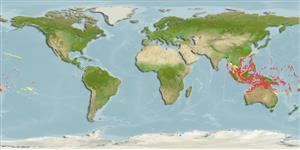Common names from other countries
>
Acanthuriformes (Surgeonfishes) >
Pomacanthidae (Angelfishes)
Etymology: Paracentropyge: Greek, para = the side of + greek, kentron = sting + Greek, pyge = tail (Ref. 45335).
More on authors: Smith & Radcliffe.
Environment: milieu / climate zone / depth range / distribution range
Ecología
marino asociado a arrecife; no migratorio; rango de profundidad 7 - 100 m (Ref. 9710), usually 20 - 70 m (Ref. 9710). Tropical; 35°N - 25°S
Indo-Pacific: Cocos-Keeling Atoll to the Society Islands, north to the Yaeyama Islands, south to the Great Barrier Reef.
Tamaño / Peso / Age
Maturity: Lm ? range ? - ? cm
Max length : 12.0 cm TL macho / no sexado; (Ref. 48636)
Espinas dorsales (total) : 13; Radios blandos dorsales (total) : 17 - 19; Espinas anales: 3; Radios blandos anales: 17 - 18.
Inhabits ledges and caves and crevices of steep outer reef slopes; occasionally found in clear lagoon reefs (Ref. 9071). It is secretive and rarely goes out more than a few centimeters from an escape hole (Ref. 9710). Forms pairs or small groups. Usually starves when kept in captivity (Ref. 48391). Often upside-down (Ref. 48636). Occasionally exported through the aquarium trade. Maximum depth reported taken from Ref. 128797.
Life cycle and mating behavior
Maturities | Reproducción | Spawnings | Egg(s) | Fecundities | Larva
Burgess, W.E., 1991. Two new genera of angelfishes, family Pomacanthidae. Trop. Fish Hobbyist , March 1991:68-70. (Ref. 9071)
IUCN Red List Status (Ref. 130435)
CITES (Ref. 128078)
Not Evaluated
Threat to humans
Harmless
Human uses
Pesquerías: comercial; Acuario: Comercial
Herramientas
Special reports
Download XML
Fuentes de Internet
Estimates based on models
Preferred temperature (Ref.
115969): 25.3 - 29.1, mean 27.5 (based on 348 cells).
Phylogenetic diversity index (Ref.
82804): PD
50 = 1.0000 [Uniqueness, from 0.5 = low to 2.0 = high].
Bayesian length-weight: a=0.03090 (0.01359 - 0.07026), b=2.89 (2.70 - 3.08), in cm Total Length, based on LWR estimates for this (Sub)family-body shape (Ref.
93245).
Nivel trófico (Ref.
69278): 2.8 ±0.33 se; based on food items.
Resiliencia (Ref.
120179): Alto, población duplicada en un tiempo mínimo inferior a 15 meses (Preliminary K or Fecundity.).
Fishing Vulnerability (Ref.
59153): Low vulnerability (10 of 100).
